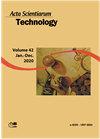由桉树木屑与萝卜或玉米芯饼组成的农用工业残留物混合制成的压块
IF 0.6
4区 综合性期刊
Q3 MULTIDISCIPLINARY SCIENCES
引用次数: 1
摘要
农工部门产生废物和(或)副产品是不可避免的,视情况而定,可能导致处置不当。本研究的目的是评价桉树木屑与萝卜或玉米芯饼混合组成的农工废渣的物理性质和能量活力。试验采用完全随机设计,共8个处理,将桉树木屑与萝卜/玉米芯饼混合施用。通过即时分析、热值分析和热重分析对纯残留物进行了表征。对于蜂窝煤,立即分析;表观和能量密度;进行了直径抗压性、HCV、LCV和热重分析。在统计分析方面,定性分析采用Tukey’s检验,定量分析采用回归分析,统计软件为Sisvar。随着饲料萝卜饼添加量的增加,挥发性物质含量降低;50%的牧草萝卜饼和50%的桉树(TN50)的组成占比76.38%,15%的桉树饼的组成占比79.87%。灰分由3.25% (TN15)增加到6.27% (TN50)。随着萝卜饼的添加,HCV从17.73% (TN15)下降到16.96% (TN50), LCV从16.38% (TN15)下降到15.64% (TN50)。在热图中,不同混合物出现峰的温度是相似的。在抗性试验中,饲料萝卜饼的添加量显著影响残茬的添加量,从0.76 MPa (TN15)增加到1.52 MPa (TN50)。考虑到所进行的分析,并将其与文献结果进行比较,可以验证由饲料萝卜饼和玉米芯制成的压块都具有能量潜力。本文章由计算机程序翻译,如有差异,请以英文原文为准。
Briquettes produced from the mixture of agro-industrial residues composed of eucalyptus sawdust with turnip or corn cob cake
The generation of waste and/or by-products in the agro-industrial sector is inevitable and, depending on the situation, it can lead to inadequate disposal. The aim of this study was to evaluate the physical properties and the energetic viability of agro-industrial residues composed of the mixture of eucalyptus sawdust with turnip or corn cob cake. The experiment was set up in a completely randomized design with eight treatments, resulting from the mixture of eucalyptus sawdust with turnip/corn cob cake. Pure residues were characterized by immediate analysis, calorific value and thermogravimetric analysis. For briquettes, immediate analysis; apparent and energetic density; diametrical compression resistance, HCV, LCV and thermogravimetric analysis were carried out. For statistical analyses, the Tukey's test was applied in qualitative analyses and regression was used in quantitative analyses with the Sisvar statistical software. The volatile material content decreases as forage turnip cake is added; the composition of 50% of forage turnip cake and 50% of eucalyptus (TN50) presented 76.38% of it, while composition containing 15% of cake, 79.87%. The ash content increased from 3.25% (TN15) to 6.27% (TN50). Both HCV and LCVdecreased with the addition of turnip cake from 17.73% (TN15) to 16.96% (TN50) for HCV and from 16.38% (TN15) to 15.64% (TN50) for LCV. In thermograms, the temperature at which peaks appear is similar among the different mixtures. In the resistance test, the addition of forage turnip cake significantly influenced the addition of residues, increasing from 0.76 MPa (TN15) to 1.52 MPa (TN50). Considering the analyses carried out, and comparing them with results in literature, it is possible to verify that both, briquettes produced from forage turnip cake and those made from corn cob, have energy potential.
求助全文
通过发布文献求助,成功后即可免费获取论文全文。
去求助
来源期刊

Acta Scientiarum-technology
综合性期刊-综合性期刊
CiteScore
1.40
自引率
12.50%
发文量
60
审稿时长
6-12 weeks
期刊介绍:
The journal publishes original articles in all areas of Technology, including: Engineerings, Physics, Chemistry, Mathematics, Statistics, Geosciences and Computation Sciences.
To establish the public inscription of knowledge and its preservation; To publish results of research comprising ideas and new scientific suggestions; To publicize worldwide information and knowledge produced by the scientific community; To speech the process of scientific communication in Technology.
 求助内容:
求助内容: 应助结果提醒方式:
应助结果提醒方式:


